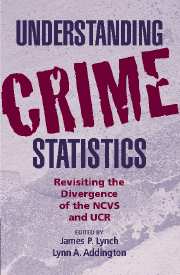Book contents
- Frontmatter
- Contents
- Acknowledgments
- Contributor Biographies
- INTRODUCTION
- OVERVIEW OF THE TWO NATIONAL MEASURES OF U.S. CRIME
- 2 Introduction to the National Crime Victimization Survey
- 3 Introduction to the Uniform Crime Reporting Program
- DEFINING DIVERGENCE AND CONVERGENCE
- SOURCES OF DIVERGENCE IN THE NCVS
- SOURCES OF DIVERGENCE IN THE UCR
- CONCLUSION
- Index
- CAMBRIDGE STUDIES IN CRIMINOLOGY
- References
2 - Introduction to the National Crime Victimization Survey
Published online by Cambridge University Press: 23 December 2009
- Frontmatter
- Contents
- Acknowledgments
- Contributor Biographies
- INTRODUCTION
- OVERVIEW OF THE TWO NATIONAL MEASURES OF U.S. CRIME
- 2 Introduction to the National Crime Victimization Survey
- 3 Introduction to the Uniform Crime Reporting Program
- DEFINING DIVERGENCE AND CONVERGENCE
- SOURCES OF DIVERGENCE IN THE NCVS
- SOURCES OF DIVERGENCE IN THE UCR
- CONCLUSION
- Index
- CAMBRIDGE STUDIES IN CRIMINOLOGY
- References
Summary
If we knew more about the character of both offenders and victims, the nature of their relationships and the circumstances that create a high probability of crime conduct, it seems likely that crime prevention and control programs could be made much more effective.
The President's Commission on Law Enforcement and the Administration of Justice, 1967aFor more than 30 years, the National Crime Victimization Survey (NCVS) and its predecessor the National Crime Survey (NCS) have provided detailed information about the nature and extent of personal and property victimization in the United States. Much of our current understanding about crime, such as the most vulnerable segments of the population, the proportion of crime involving weapons, the types of injuries sustained in violent crimes, and the extent of reporting to police, is derived from the NCS and NCVS. The NCVS also serves as a model for victimization surveys implemented throughout the world because it incorporates many innovative methodological protocols that enhance its ability to produce reliable estimates of the nature and extent of criminal victimization. These methodological techniques combined with the large sample size and the extensive details collected by the survey on crime events are all reasons that the current NCVS remains the “most comprehensive and systematic survey of victims in the United States” (Mosher et al., 2002, p. 137).
The NCVS and the Uniform Crime Reporting System (UCR) comprise the two ongoing national measures of crime in the United States.
- Type
- Chapter
- Information
- Understanding Crime StatisticsRevisiting the Divergence of the NCVS and the UCR, pp. 17 - 54Publisher: Cambridge University PressPrint publication year: 2006
References
- 8
- Cited by

